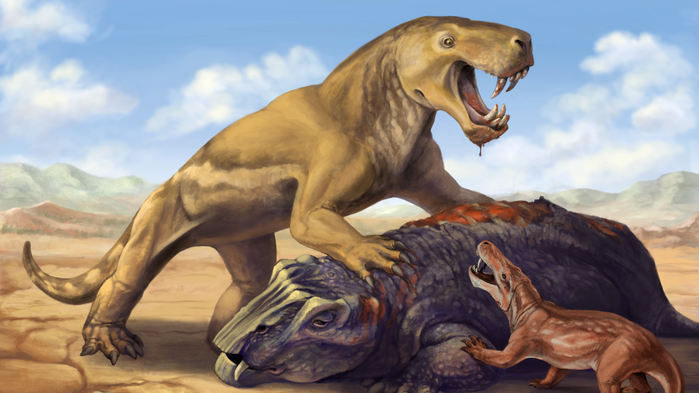Fearsome saber-toothed giant dominated at dawn of 'Great Dying', but its reign was short-lived
Inostrancevia, a creature with tough skin like a rhino's, migrated 7,000 miles across the ancient supercontinent Pangaea and briefly dominated what is now South Africa before going extinct.

At the dawn of the most devastating mass extinction in Earth's history 252 million years ago, species fought tooth and nail to survive in the changing environment. Ancient predators in particular, struggled ruthlessly to stay at the top of the food chain.
Now, scientists have discovered that a tiger-size, saber-toothed beast called Inostrancevia briefly dominated southern ecosystems after migrating across the supercontinent Pangaea from what is now Russia to South Africa.
Inostrancevia belonged to an ancient group of mammals called the gorgonopsians that went extinct during the “Great Dying,” also known as the Permian-Triassic or late-Permian mass extinction. The fearsome carnivore had tough skin like an elephant or rhinoceros and looked somewhat reptilian.
"All the big top predators in the late Permian in South Africa went extinct well before the end-Permian mass extinction," Pia Viglietti, a research scientist at the Field Museum of Natural History in Chicago who participated in the discovery, said in a statement. "We learned that this vacancy in the niche was occupied, for a brief period, by Inostrancevia."
Based on previous fossil discoveries, researchers thought that this saber-toothed giant was endemic to Laurasia — the northern continental mass of Pangaea. Today this encompasses North America, Greenland, Europe and northern Asia.
But in 2010 and 2011, paleontologists unearthed two gigantic skulls and a skeleton in South Africa's Karoo Basin that looked different to those normally found in the region. "The fossils themselves were quite unexpected," Viglietti said.
Related: Ancient saber-toothed 'gorgons' bit each other in ritualized combat
Sign up for the Live Science daily newsletter now
Get the world’s most fascinating discoveries delivered straight to your inbox.
In a study published Monday (May 22) in the journal Current Biology, the researchers found that the remains discovered in South Africa belong to Inostrancevia and that the creature traveled around 7,000 miles (11,300 kilometers) south during the late Permian.
Once there, it replaced a group of endemic predators called the rubidgeines — a subset of gorgonopsians that had a large snout and blade-like canines. The local carnivores of Karoo went extinct "quite a bit" before the Great Dying truly set in, Viglietti said.
It's unclear how and over what timescales Inostrancevia crossed Pangaea, but it appears that the carnivore filled a gap in ecosystems that had lost their top predators. Its reign was short-lived, however: The team found no evidence that Inostrancevia survived into the Triassic (252 million to 201 million years ago).
Massive volcanic eruptions towards the end of the Permian triggered catastrophic climate change, wiping out nine out of 10 species on the planet. Some gorgonopsians persisted, but they didn't survive for long and have been referred to as a "dead clade walking."
Due to their large body sizes, slow maturation rates and low population densities, top predators are often some of the first species to disappear during mass extinction events.
"Apex predators in modern environments tend to show high extinction risk," study lead author Christian Kammerer, a paleontologist at the North Carolina Museum of Natural Sciences, said in the statement. "We should expect that ancient apex predators would have had similar vulnerabilities."
When it went extinct at the end of the Permian, Inostrancevia left a gap at the top of the food chain that other predators, called therocephalians, rapidly filled before themselves going extinct. Therocephalians are thought to have originated in what is now southern Africa and spread to Russia, China and Antarctica, where fossils have also been found.
“We have shown that the shift in which groups of animals occupied apex predator roles occurred four times over less than two million years around the Permian-Triassic mass extinction," Kammerer said. "This underlines how extreme this crisis was.”
The discovery suggests that top predators were "canaries in the coal mine" for the mass extinction and sheds light on the great die-out that’s unfolding today. "The Permo-Triassic mass extinction event represents one of the best examples of what we could experience with our climate crisis and extinctions," Viglietti said.

Sascha is a U.K.-based staff writer at Live Science. She holds a bachelor’s degree in biology from the University of Southampton in England and a master’s degree in science communication from Imperial College London. Her work has appeared in The Guardian and the health website Zoe. Besides writing, she enjoys playing tennis, bread-making and browsing second-hand shops for hidden gems.










